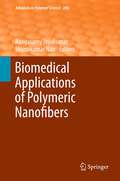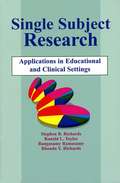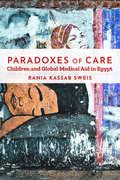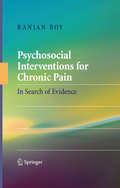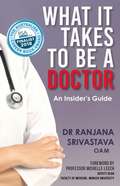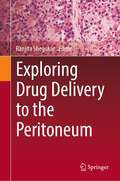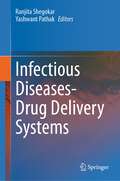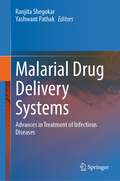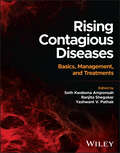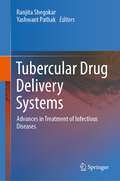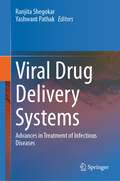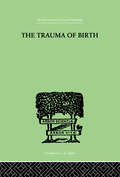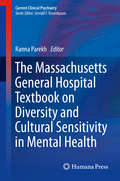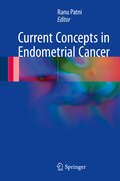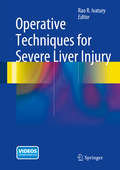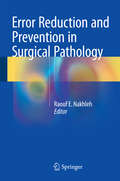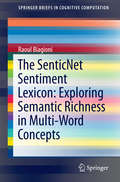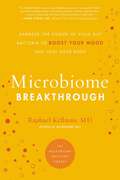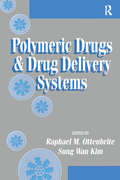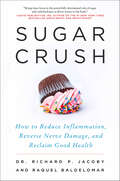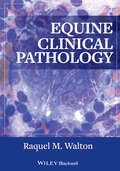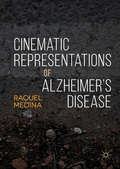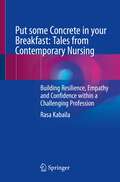- Table View
- List View
Biomedical Applications of Polymeric Nanofibers (Advances in Polymer Science #246)
by Rangasamy Jayakumar Shantikumar NairMultiscale Fibrous Scaffolds in Regenerative Medicine, by Sowmya Srinivasan, R. Jayakumar, K. P. Chennazhi, Erica J. Levorson, Antonios G. Mikos and Shantikumar V. Nair; Stem Cells and Nanostructures for Advanced Tissue Regeneration, by Molamma P. Prabhakaran, J. Venugopal, Laleh Ghasemi-Mobarakeh, Dan Kai Guorui Jin and Seeram Ramakrishna; Creating Electrospun Nanofiber-Based Biomimetic Scaffolds for Bone Regeneration, by Eleni Katsanevakis, Xuejun Wen and Ning Zhang; Synthetic/Biopolymer Nanofibrous Composites as Dynamic Tissue Engineering Scaffolds, by J. A. Kluge and R. L. Mauck; Electrospun Fibers as Substrates for Peripheral Nerve Regeneration, by Jörg Mey, Gary Brook, Dorothée Hodde and Andreas Kriebel; Highly Aligned Polymer Nanofiber Structures: Fabrication and Applications in Tissue Engineering, by Vince Beachley, Eleni Katsanevakis, Ning Zhang, Xuejun Wen; Electrospinning of Biocompatible Polymers and Their Potentials in Biomedical Applications, by Pitt Supaphol, Orawan Suwantong, Pakakrong Sangsanoh, Sowmya Srinivasan, Rangasamy Jayakumar and Shantikumar V. Nair; Electrospun Nanofibrous Scaffolds-Current Status and Prospects in Drug Delivery, by M. Prabaharan, R. Jayakumar and S. V. Nair.; Biomedical Applications of Polymer/Silver Composite Nanofibers, by R. Jayakumar, M. Prabaharan, K. T. Shalumon, K. P. Chennazhi and S. V. Nair.-
Single Subject Research: Application in Educational and Clinical Settings
by Stephen B. Richards Ronald Taylor Rangasamy Ramasamy Rhonda Y. RichardsThis practical, user-friendly textbook provides background knowledge, basic concepts, and understanding of relevant issues related to applied behavior analysis and specifically to single subject research designs.
Paradoxes of Care: Children and Global Medical Aid in Egypt (Stanford Studies in Middle Eastern and Islamic Societies and Cultures)
by Rania Kassab SweisEach year, billions of dollars are spent on global humanitarian health initiatives. These efforts are intended to care for suffering bodies, especially those of distressed children living in poverty. But as global medical aid can often overlook the local economic and political systems that cause bodily suffering, it can also unintentionally prolong the very conditions that hurt children and undermine local aid givers. Investigating medical humanitarian encounters in Egypt, Paradoxes of Care illustrates how child aid recipients and local aid experts grapple with global aid's shortcomings and its paradoxical outcomes. Rania Kassab Sweis examines how some of the world's largest aid organizations care for vulnerable children in Egypt, focusing on medical efforts with street children and out-of-school village girls. Her in-depth ethnographic study reveals how global medical aid fails to "save" these children according to its stated aims, and often maintains—or produces new—social disparities in children's lives. Foregrounding vulnerable children's responses to medical aid, Sweis moves past the unquestioned benevolence of global health to demonstrate how children must manage their own bodies and lives in the absence of adult care. With this book, she challenges readers to engage with the question of what medical caregivers and donors alike gain from such global humanitarian transactions.
Psychosocial Interventions for Chronic Pain
by Ranjan RoyThis book fills a major gap in the practice literature for healthcare professionals engaged in providing psychosocial care for their patients suffering from chronic pain or illness. Up to now there has been little published material on evidence-based medicine in this field. Roy's book at last provides empirically derived support and understanding of psychosocial problems and explores the efficacy of the interventions available for patient care. A boon for clinical psychologists.
Social Support, Health, and Illness
by Ranjan RoyWhen a person faces serious illness, having the support of one's partner can help protect against the full ravages of disease, and even hasten recovery. However, too much support can have grave clinical consequences for sufferers and exact a heavy emotional and financial toll on caregivers. Social Support, Health, and Illness is an up-to-date analysis of how social support can either help or hinder recovery for patients.A useful resource for clinical practitioners and researchers, Social Support, Health, and Illness addresses the effects of intimate support on a wide variety of medical and psychiatric conditions, including cancer, dementia, and chronic pain. Ranjan Roy uncovers the complexities underlying social support by tracing the concept's historical and theoretical development. Synthesizing insights from the latest research findings, Social Support, Health, and Illness offers a comprehensive look at the modifying and mitigating factors of intimacy on the outcomes of disease.
What It Takes to Be a Doctor: An Insider's Guide
by Ranjana SrivastavaIf you, or someone you know, is thinking of becoming a doctor, you can’t go past this essential guide from one of Australia’s finest doctors – and writers. What is the life of a doctor really like? Is there an end to studying? Are money and prestige guaranteed? Can a fulfilling medical career and a satisfying family life co-exist and what support can a parent or partner give? Which doctors are the happiest? What is the most important question to ask yourself before studying medicine? An insider’s calm and considered answers could determine whether you choose to pursue this high-stakes career. Becoming a doctor is a tremendous privilege and a serious responsibility. With her trademark warmth and story-telling ability, Ranjana Srivastava delves into the reality of being a doctor in the modern era of medicine. Through lived experience as a front-line clinician, prolific writer, and mother, she celebrates the highlights of being a doctor but doesn't flinch from the disappointments. Her compelling stories illustrate the hidden facets of a life in medicine. From the burden of prolonged medical training and the regret of mismatched expectations, to the humility of caring and the joy of making a difference, this book contains illuminating observations, reflection and advice that should be required reading for anyone contemplating a career as a doctor.
Exploring Drug Delivery to the Peritoneum
by Ranjita ShegokarThe Peritoneal cavity (PC) is the key metastatic site for intra-abdominal malignancies (e.g., GI tract and rectal cancer). PC sites can be used to target several other diseases where lymphatic drug delivery is desired without dumping large amounts of the drug. Till recently, it was thought that treatment with curative intent was impossible but that was challenged by the introduction of cytoreductive surgery (CRS) and heated intraperitoneal chemotherapy (HIPEC), and PIPAC (pressurized intraperitoneal aerosol chemotherapy). Recently, a growing number of preclinical and clinical studies advocate intraperitoneal (IP) chemotherapy as an alternative post-operative therapy for cancer. Although their effectiveness has been proven both experimentally and clinically, there is still little understanding of the role of drug delivery systems (DDS) in targeting drugs in the intraperitoneal (IP) cavity.There are two main challenges one posed by IP cavity where the residence time of a small molecular weight drug (In summary, challenges like delivery to IP cavity, tumor or organ-specific targeting, efficient tissue penetration, optimal cellular uptake and intracellular residence of a drug, biocompatibility, toxicity, etc can be easily solved by smartly designing functional drug delivery systems (both nano and micro). Nanotechnologies have always fascinated humans for several decades and are now widely explored in the biomedical field. Diverse types of nanoparticles are being explored around the world, some examples include biodegradable nanoparticles, green nanoparticles, polymeric nanoparticles, lipid nanoparticles, metal nanoparticles, graphene, carbon nanotubes, and several others. Now a day's nanoparticles are gaining interest for drug targeting of chemotherapeutic drugs, immunotherapy, and gene delivery. Whereas microparticles can be explored for delayed drug delivery to the peritoneal cavity due to relatively slow removal from IP fluid. Hydrogels or other adhesive drug delivery may help to enhance peritoneal adhesions; thereby maintaining the balance between benefit and risk. Overall, drug delivery systems are key in IP targeting. That means drug delivery specialist and clinician needs to be connected to get the best out of this route of drug administration.The present book is a link between pharmaceutical scientists (drug formulators), clinicians, toxicologists, and regulatory experts. This book also provides a new perspective to researchers to divert or guide their research in an optimal way. Exploring Drug Delivery to the Peritoneum serves as a platform for upcoming technologies especially in the medical devices sector to face up and show potential in delivering drugs. It is a chance for commercial partners like insurance companies and the pharma industry to explore this direction.
Infectious Diseases Drug Delivery Systems
by Yashwant Pathak Ranjita ShegokarThe disability-adjusted life year (DALY) is a generic measure of health effect that can be used in cost-effectiveness analysis as an alternative to the quality-adjusted life year (QALY). Infectious diseases are one of the major to cause significant losses of DALY and QALY. Human infectious diseases are disorders that are triggered by the micro-organisms such as bacteria, fungi, viruses, or parasites. The majority of such diseases are contagious and create a public health menace. There are several reasons why infectious diseases are deadly diseases, and one of the primary reasons is the drug resistance developed over time. Drug resistance-associated mutations are linked to increasing drug efflux, modifications of the drugs, or their targets. Every year, new drugs are being approved by FDA to treat infectious diseases. Nonetheless, the infectious diseases will undoubtedly persist as permanent and main threats to humanity for now and in the future.A total of four books are covered under the series of Infectious drug diseases.- Malarial drug delivery systems- Tubercular drug delivery systems- Viral drug delivery systems- Infectious disease drug delivery systemsInfectious diseases are the world’s greatest killers that present one of the most significant health and security challenges. Humans have lived with emerging and re-emerging pathogens since before the documented history of civilization. The only determining fact today is - If the situation is “worse” or “better” than in past. The answer is probably “worse”, may be due significant increase in human population, increased cross-continent mobility, imbalanced (stressed) life style, irregular food habits leading to compromised innate immunity and over or under practiced hygiene routine. When the incidence of such a disease in people increases over 20 years or threatens to increase, it is called an “emerging” disease, and a growing number have made watch lists and headlines in nearly every country -like highly pathogenic H5N1 avian influenza, severe acute respiratory syndrome (SARS), Ebola virus, food- and waterborne illnesses, and a range of antimicrobial-resistant bacterial diseases TB. This book addresses current and new therapy developments in treating such infectious diseases, updates on finding new drugs, identification of innovative diagnostic methods, understanding of disease research models and clinical trials performances of new treatment modalities.Audiences from a broad range of groups, from researchers, academicians, and public health bodies to regulatory experts, can benefit from the compiled information to learn more about patient needs and current research advances in the field of infectious diseases and related research.
Malarial Drug Delivery Systems: Advances in Treatment of Infectious Diseases
by Yashwant Pathak Ranjita ShegokarThis book targets new advances in areas of treatment and drug delivery sciences for Malaria. This is the only published book which compiles the complete road map of malarial drug delivery systems along with an overview on the pathology, current state of malaria across the globe, new clinical trials, emerging drugs and evolving novel drug delivery platforms. A wide variety of novel micro-and nano-formulations using promising technologies are being explored to deliver the malarial drug via different administration routes. This book addresses the gap between new approaches and old treatment modalities and how the former is superior in pharmacological performance when tested in in-vitro and in-vivo. Audience from wide range group like from researchers to regulatory bodies can benefit from the compiled information to find out patient needs and addresses a much-needed update to the existing malaria drug delivery research.
Rising Contagious Diseases: Basics, Management, and Treatments
by Ranjita Shegokar Yashwant V. Pathak Seth Kwabena AmponsahComprehensive yet succinct insight into the prevention, diagnosis, and treatment of infectious diseases including COVID-19, mpox, Ebola, and Lyme disease Rising Contagious Diseases provides basic information about preventing and treating threatening infectious diseases from viral, bacterial, and parasitic sources, including 28 emerging or recurring diseases like COVID-19, mpox, Ebola, bird and swine flu, malaria, Legionnaires', and others. The text highlights molecular surveillance and epidemiology (including zoonotic pathogens or their variants), innovative strategies for pathogen detection, drug and vaccine development, appropriate preventive measures, cost-effective diagnostic procedures (assays), and effective therapeutic strategies. The text is unique due to its broad coverage of today’s infectious diseases, covering several which are not similarly addressed elsewhere, with detailed insight from experts around the world. Composed of 30 chapters of fundamental facts alongside practical and clinical data, Rising Contagious Diseases covers sample topics such as: Re-emergence of certain diseases in recent decades due to dynamic host-pathogen interactions, anthropogenic selection, and climate change How real-time epidemiological surveillance can improve detection of infectious disease outbreaks or new infections of public health importance Up-to-date insight on transmission dynamics, epidemiology, clinical manifestation, advances in diagnostics, and management of covered diseases Effects of disease outbreaks on the world at large, such as through high morbidity and mortality rates and rising healthcare costs With detailed insight on the prevention, diagnosis, and treatment of infectious diseases, Rising Contagious Diseases is an essential reference for health care professionals, academics in the field of microbiology, immunology, infectious diseases, pathology, pharmacology and public health, and undergraduates and postgraduates in related disciplines.
Tubercular Drug Delivery Systems: Advances in Treatment of Infectious Diseases
by Yashwant Pathak Ranjita ShegokarThe book targets new advances in areas of treatment and drug delivery sciences for tuberculosis. It covers advances in drug therapy and drug targeting that focus on innovative trend defining technologies and drug delivery platforms in the understanding of host-pathogens relationship for providing better therapy. A wide variety of novel and nano-formulations using promising technologies are being explored to deliver the drug via different administration routes. This book It addresses the gap between new approaches and old treatment modalities and how they are superior in pharmacological performance when tested in in-vitro and in-vivo. Audience from wide range group like from researchers to regulatory bodies can benefit from the compiled information to find out patient needs and current research advances in the field of tuberculosis research..
Viral Drug Delivery Systems: Advances in Treatment of Infectious Diseases
by Yashwant Pathak Ranjita ShegokarThe disability-adjusted life year (DALY) is a generic measure of health effect that can be used in cost-effectiveness analysis as an alternative to the quality-adjusted life year (QALY). Infectious diseases are one of the major to cause significant losses of DALY and QALY. Human infectious diseases are disorders that are triggered by the micro-organisms such as bacteria, fungi, viruses, or parasites. The majority of such diseases are contagious and create a public health menace. There are several reasons why infectious diseases are deadly diseases, and one of the primary reasons is the drug resistance developed over time. Drug resistance-associated mutations are linked to increasing drug efflux, modifications of the drugs, or their targets. Every year, new drugs are being approved by FDA to treat infectious diseases. Nonetheless, the infectious diseases will undoubtedly persist as permanent and main threats to humanity for now and in the future, primarily due to increased longevity that almost always comes at a cost of impaired immunity.A total of four books are covered under the series of Infectious drug diseases.- Malarial drug delivery systems- Tubercular drug delivery systems- Viral drug delivery systems- Infectious disease drug delivery systemsThe third volume of series is focused on viral drug delivery systems. Typically, virus attaches to the cells (referred as host cell) and releases its DNA or RNA inside the cell. In second stage, virus’s genetic material takes control of the cell and forces it to replicate the virus leading to onset of disease symptoms. DNA class of viruses include Herpes, Papilloma and Adeno viruses. RNA class of viruses include retroviruses, such as HIV immunodeficiency virus and SARS COV – 2 / Corona virus. This book addresses recent developments in viral drug delivery systems. It covers many different aspects of viral infections, ways to treat them using modern drug delivery systems like nano particulate carriers. The choice of viral delivery systems mainly depends upon the type of virus, duration of life cycle, presence of drug resistance, cellular and mucosal interaction of virus, accordingly gene or non-gene drug delivery systems are selected. Besides that, this book also reports global dynamics of viral diseases, future predictions of infection rate, current treatment options, details of drug carriers like nanoemulsions, polymeric nanoparticles, role of biofunctionalization, and phyto-molecules in treatment of viral infections particularly herpes, Covid-19, Ebola, HIV/AIDS, influenza and viral hepatitis.Audiences from a broad range of groups, from researchers, academicians, and public health bodies to regulatory experts, can benefit from the compiled information to learn more about patient needs and current research advances in the field of viral drug delivery research.
The Trauma Of Birth (International Library Of Psychology Ser.)
by Rank, OttoFirst Published in 1999. This text outlines developments in psycho-analysis, from the consistent application of the method created by Freud and from the dotrine based on the method. The authors seek to gain a general and wider knowledge of the Unconscious.
The Massachusetts General Hospital Textbook on Diversity and Cultural Sensitivity in Mental Health
by Ranna ParekhLong considered important for professionals working with minority and under-represented populations, cross-cultural competency has become a requisite for all health care providers. As society in the US increasingly diversifies, there is a crucial need to prepare health care professionals to effectively treat this changing population. The Massachusetts General Hospital Textbook on Diversity and Cultural Sensitivity in Mental Health addresses the importance and relevance of cultural sensitivity in US mental health. Prominent researchers and clinicians examine the cultural and cross-cultural mental health issues of Native American, Latino, Asian, African American, Middle Eastern, Refugee and LGBQT communities. The discussion includes understanding the complexities in making mental health diagnoses and the various meanings it has for the socio-cultural group described, as well as biopsychosocial treatment options and challenges. In understanding the specific populations, the analysis delves into overarching concepts that may apply to specific populations and to those at the intersection of multiple cultures. An invaluable resource for mental health professionals, including clinicians, researchers, educators, leaders and advocates in the United States, The Massachusetts General Hospital Textbook on Diversity and Cultural Sensitivity in Mental Health provides the necessary understanding and insights for research and clinical practice in specific cultural and multicultural groups.
Current Concepts in Endometrial Cancer
by Ranu PatniThis book comprehensively covers endometrial carcinoma, a type of gynecological cancer that is often overlooked but of great interest. Although the incidence of the disease is rapidly increasing, both per se and as part of familial cancer syndromes, there is a great deal of controversy regarding its diagnosis, evaluation and management. This book underlines the significance of endometrial carcinoma, highlights key prevention measures, charts its evaluation, and addresses the stage-by-stage management of this malignancy, with particular attention to the role of minimally invasive surgery. Further, it includes a chapter on future perspectives including robotics, targeted therapies and other developments in the offing. Overall, the book provides a comprehensive guide to endometrial cancer, which if approached properly, can have an excellent prognosis, thus saving many lives and/or achieving substantially improved quality of life. >
Operative Techniques for Severe Liver Injury
by Rao R. IvaturyThis volume is a complete manual of operative techniques for battling a severe liver injury. It provides an easy pre-operative and intra-operative reference with clear illustrations, line drawings as well as actual intra-operative color pictures, supplemented by online video segments. The early sections of the book deal with the fundamentals of surgical anatomy and critical maneuvers in the resuscitation of the patient in extremis. The various technical maneuvers for manual control of hemorrhage, debridement-resection as well as formal lobectomy of the liver, the identification of biliary tract injuries and other miscellaneous techniques, such as balloon tamponade of missile tracts, are discussed in complete detail. The book also sketches the role of liver transplantation surgeons in the acute trauma setting. The final chapters focus on the urgent problem of teaching operative techniques to young trauma surgeons in an era of dwindling surgical experience. Written by authors who are world- renowned experts in trauma management, often termed "master-surgeons", Operative Techniques for Severe Liver Injury is required preparation for all surgeons who are likely to face a massive crush injury of the liver.
Error Reduction and Prevention in Surgical Pathology
by Raouf E. NakhlehTissue diagnosis in surgical pathology is the most important determinant of patient outcomes in oncology and other medical conditions. An appropriate diagnosis of a tumor correctly determines the necessary therapy for that patient. Error Reduction and Prevention in Surgical Pathology focuses on how errors happen, the best systems to detect errors and the best systems to prevent errors. As with any form of testing, the test cycle in surgical pathology can be divided into pre-analytic (collection and handling of specimens), analytic (the actual determination of disease or other diagnostic information) and post-analytic (generation of reports and distribution). Error can occur anywhere in the process and all of these steps must be performed optimally so that the correct diagnosis is made and delivered. Error Reduction and Prevention in Surgical Pathology serves as an essential guide to a successfully managed laboratory and contains all relevant information needed to manage patients and deliver the best diagnosis.
The SenticNet Sentiment Lexicon: Exploring Semantic Richness in Multi-Word Concepts
by Raoul BiagioniThe research and its outcomes presented in this book, is about lexicon-based sentiment analysis. It uses single-, and multi-word concepts from the SenticNet sentiment lexicon as the source of sentiment information for the purpose of sentiment classification. In 6 chapters the book sheds light on the comparison of sentiment classification accuracy between single-word and multi-word concepts, for which a bespoke sentiment analysis system developed by the author was used. This book will be of interest to students, educators and researchers in the field of Sentic Computing.
Vitellogenin in Fishes- Diversification, Biological Properties, and Future Perspectives
by Vaseeharan Baskaralingam Rapeepun VanichviriyakitThis book provides basic and advanced information on vitellogenin in fish. The proposed book discusses the history of vitellogenin, previtellogenesis, their diversification and classification in fishes, and tools for their identification and characterization. Further, their functional aspects in oogenesis and its regulatory mechanism, role as the immunocompetent molecule, and reproductive strategies are discussed. The book further examines vitellogenin as a hormone and biomarker, its related egg yolk proteins, and its mechanism on molecular cloning and induction. In addition, the book discusses its role in the disruption of the endocrine system in fish, its biological activities, its multivalent mechanism in marine and freshwater fishes, and its impact on the growth of ornamental fishes. Moreover, this book elaborates on the multiple vitellogenin genes, each with unique promoter regions and varying sensitivity to induction by estradiol, and multiple Vtg proteins themselves, with variable degrees of post-translational modification. As such, this book is helpful for researchers and students interested in the reproduction of fishes and reproductive biology.
The Whole Brain: The Microbiome Solution to Heal Depression, Anxiety, and Mental Fog without Prescription Drugs (Microbiome Medicine Library)
by Raphael KellmanFunctional medicine pioneer and author of The Microbiome Diet offers his groundbreaking, medication-free, scientifically based approach to healing depression, anxiety, and brain fog by focusing on your "whole brain"--the brain, the gut, the microbiome, and the thyroid.If you are one of the millions of people who feel that your brain just "isn't working right"--that you have brain fog, memory loss, depression, anxiety, or that your ability to maintain a balanced, happy mood has been lost long ago--take heart. The problem is not "in your head," it is in your microbiome (the trillions of health-promoting bacteria) and your gut--and there are proven natural solutions that can help you not only reduce symptoms but also improve your vitality, cognitive function, and zest for life.A pioneer in holistic and functional medicine, Dr. Raphael Kellman has spent the last two decades treating countless patients with complaints like these. Through years of research, he developed a groundbreaking approach to brain health that goes far beyond conventional understanding of the brain. The Whole Brain introduces you to the complete system that affects your mental health: not just your brain, but your gut, microbiome, and thyroid as well. You'll learn about the latest cutting-edge science, and will discover The Whole Brain Protocol. This powerful four-week plan advises you exactly what to eat and which supplements and probiotics to take, so that your brain functions at its deepest level, every day, all the time. Along with delicious, health-supporting recipes, meal plans, and other tips and strategies, The Whole Brain will help you make your own brain work better so that you can feel calm, energized, clear, sharp, and optimistic--without prescription medications.
Polymeric Drugs and Drug Delivery Systems (Acs Symposium Ser. #No. 469)
by Raphael M. Ottenbrite Sung Wan KimPolymeric materials are now playing an increasingly important role in pharmaceuticals, as well as in sensing devices, in situ prostheses and probes, and microparticle diagnostic agents. This new volume consists of twenty-two recent research-based reports on the developments in these areas of pharmaceutical and biomaterials technology. The reports w
Sugar Crush: How to Reduce Inflammation, Reverse Nerve Damage, and Reclaim Good Health
by Raquel Baldelomar Richard P. JacobyA shocking look at the link between sugar, inflammation, and a host of preventable chronic diseases—perfect for fans of bestselling author Gary Taubes’ The Case Against Sugar—from leading nerve surgeon Dr. Richard Jacoby. What Grain Brain did for wheat, this book by a leading peripheral nerve surgeon now does for sugar, revealing how it causes crippling nerve damage throughout the body—in our feet, organs, and brain—why sugar and carbohydrates are harmful to the body's nerves, and how eliminating them can mitigate and even reverse the damage.If you suffer from ailments your doctors can’t seem to diagnose or help—mysterious rashes, unpredictable digestive problems, debilitating headaches, mood and energy swings, constant tiredness—nerve compression is the likely cause. Sugar Crush exposes the shocking truth about how a diet high in sugar, processed carbohydrates, and wheat compresses and damages the peripheral nerves of the body, leading to pain, numbness, and tingling in the hands and feet, along with a host of related conditions, including migraines, gall bladder disease, and diabetes.Over the years, Dr. Richard Jacoby has treated thousands of patients with peripheral neuropathy. Now, he shares his insights as well as the story of how he connected the dots to determine how sugar is the common denominator of many chronic diseases. In Sugar Crush, he offers a unique holistic approach to understanding the exacting toll sugar and carbs take on the body. Based on his clinical work, he breaks down his highly effective methods, showing how dietary changes reducing sugar and wheat, coinciding with an increase of good fats, can dramatically help regenerate nerves and rehabilitate their normal function.Sugar Crush includes a quiz to assess your nerve damage, practical dietary advice, and the latest thinking on ways to prevent and reverse neuropathy. If you have diabetes, this essential guide will help you understand the dangers and give you the tools you need to make a difference beyond your doctor’s prescriptions. If you have the metabolic syndrome or prediabetes, or are just concerned about your health, it will help you reverse and prevent nerve damage.
Equine Clinical Pathology
by Raquel M. WaltonEquine Clinical Pathology is the first complete resource for hematology and clinical chemistry in horses. Encompassing the basic principles and advanced interpretation, the book's single-species approach to pathology allows for focused coverage of the unique disease characteristics of equids. Equine Clinical Pathology is equally useful for anyone using clinical pathology as a diagnostic tool, from beginning student to experienced specialist.The heart of the book is organized by body system, making it easy to find and apply information. Chapters cover general laboratory medicine, including instruments and techniques, hematology, and proteins as well as specific organs, such as the kidney and liver. Equine Clinical Pathology is a useful bench-side reference for anyone involved in laboratory medicine for the horse.
Cinematic Representations of Alzheimer’s Disease
by Raquel MedinaThis book offers a cross-cultural approach to cinematic representations of Alzheimer’s disease in non-mainstream cinema. Even though Alzheimer’s disease, the most common form of dementia, is a global health issue, it is not perceived or represented homogenously around the world. Contrary to very well-known mainstream films, the films discussed do not focus on the negative aspects normally associated with Alzheimer’s disease, but on the importance of portraying the perspective of the persons living with Alzheimer’s and their personhood. Similarly, this book analyses how the films use Alzheimer’s as a trope to address issues relating to different areas of life and society such as, for example, family matters, intergenerational relationships, gender issues, national traditions versus global modernity, and caring for people with dementia. By examining an array of films, from crime fiction to documentary, that each present non-stigmatising representations of Alzheimer’s disease, this in-depth study ultimately demonstrates the power of culture in shaping meaning.
Put some Concrete in your Breakfast: Building Resilience, Empathy and Confidence within a Challenging Profession
by Rasa KabailaThis book gives a sincere yet honest representation of modern nursing in all its forms rather than purely focusing only on the ‘good’ ‘the funny’ ‘the sad’ or the ‘ugly’. This book provides a collection of stories that concentrate on nursing, that validates, educates and encourages those undertaking a career in nursing. In addition, this book also celebrates the amazing rewards that the unique career of nursing has to offer, for those who can find a way to persevere through the challenges. There is a high rate of burnout among nurses in their early days of practice, because of the high demands placed on them by the healthcare system; hospital administrations; the expectations of management, patients, families and carers; and the sheer size of the patient loads with complex needs these days. The global pandemic erupting has now pushed a health care service that was already under pressure to now be in complete crisis. The world now knows that we need more nurses employed to be able to move forward from this calamity. This book closes that gap in that it encourages the readers to continue to pursue a career in nursing (despite the challenges that the profession holds) while also positively promoting the incredible work that nurses do. The chapters within this book, explore a cornucopia of different aspects of nursing including: caring for dying patients, dealing with bodily fluids and how patients are not very good at working out how sick they really are. The book also covers how to manage the care of patients with complex mental illnesses and those contemplating suicide. This book is targeted at nurses who may feel a little overwhelmed with the world that is nursing but who wish to thrive and further their career. Discussion questions at the end of the book further add to the reflection and learning process of the reader.
